In Sandler Enterprise Selling, our KARE account profiling process has developed a worldwide following since it rolled out in 2015. It’s based on the premise that in selling, we group our accounts into designations – geographic, vertical, size-related and other logical buckets. Such categorizations certainly add clarity and should, if utilized correctly, increase efficiency. Descriptive information has value but what do you really learn from these types of bundles about clients’ traits and tendencies? How do the groupings really help you win, grow and keep enterprise accounts?
Think about the animal kingdom, where we also use designations in scientific classification. But what’s truly meaningful about knowing that two creatures are, for example, both snakes? While King Cobras and Garter Snakes are grouped together, their individual traits and tendencies are certainly quite different. And regarding spiders, wouldn’t it be more helpful to know what to expect from a Black Widow versus a Daddy Long Legs versus simply knowing that they both belong to the arachnid family? Truthfully, the category designations provide you no real information about what you should do when you encounter these creatures. The information provided is not meaningful. More importantly, given the danger, it’s not actionable.
Major accounts present us with a similar dilemma, albeit without potentially life-threatening consequences. For understanding the traits and tendencies of large clients versus simply their tactical groupings can be valuable in the same way as knowing that playing with a King Cobra is not a good idea.
But how do you make designations truly meaningful? Enter, KARE. For those unfamiliar, consider its four account profiles – Keep, Attain, Recapture and Expand. The “K” – Keep profile, represents your typical clients, likely comprising approximately 80% of your total account portfolio. You’re happy to have them and you want them to stay. Attain accounts, the “A”, are your profile prospects – those you target, hoping to win their business. The “R” – Recapture accounts are previous clients, no longer active. Unlike past clients you consciously choose not to pursue, you’d love to have Recapture accounts back onboard. The “E” is for Expand accounts – your most treasured clients. They represent your greatest growth potential and you work hard to foster extremely closer partnerships with them. These are the strategic accounts you want to tuck in at night. They are your future.
Of course, what constitutes the KARE designations is different for different selling organizations, so the profiles are customized to organizational models. And once you build your custom KARE profiles, you align them to your accounts, both clients and prospects. And last, you craft common actions for each profile. For Recapture accounts, you’ll identify the actions to win them back. For Keep, Attain and Expand accounts, you’ll also develop relevant actions, building templates to streamline your efforts. Since the accounts in each designation share the same traits and tendencies, the profiles are truly actionable. That’s the magic of KARE.
The two profiles that apply to current accounts, Keep and Expand, deserve some additional focus and discussion. For don’t you want to keep your Expand accounts? And similarly, don’t you want to expand your Keep accounts? Of course. But the fundamental difference between the designations is important. As mentioned, Keep accounts represent the majority of your clients, likely in the 80% range, following the Pareto Principle. They pay their bills, communicate effectively and meet all the basic requirements necessary to be in your client portfolio. You’re happy to have them but, truth be told, you don’t see them changing your life. Expand accounts, on the other hand, exhibit that rare life-changing potential. These highly treasured assets are potential rain-makers for your business. Their alignment to the customized Expand attributes that you and your team developed illustrates their clear potential to significantly impact growth, revenues and profitability. As a result, your ability to differentiate them from Keep accounts in your client portfolio is critical. And KARE helps you to wisely invest your organization’s time, energy, resources and finances to maximize the chances of amazing results.
What about current clients you need to jettison – accounts with pitiful margins or where simple communication doesn’t happen? They don’t get KARE profiles. They get actions. If account relationships need to be severed, you need to execute quickly. The actions you must take, however difficult, can occasionally prompt positive results as toxic clients change their ways. Truthfully, though, this doesn’t happen often. They move on and so do you, applying your precious energy to deserving clients and promising prospects.
In the end, know your accounts. But don’t accept simply knowing that Black Widows and King Cobras are spiders and snakes respectively. Comprehensively understand their traits and tendencies and why they’re killers – why they should be feared. Then, take meaningful actions. KARE…..for your accounts!













Comments (3)
An insightful article highlighting the need of careful consideration when assessing the individual value of your entire client base.
PIPELINER CRM the best crm in the world
The KARE approach to pipeline management is brilliant in the aspect of its customer centric nature in categorizing your customer base so as to enhance relationship management ,focus & eventual output. This approach can also be seen in the pipeliner CRM software that also integrates Artificial Intelligence to give you incites ,administration & focus towards productivity.